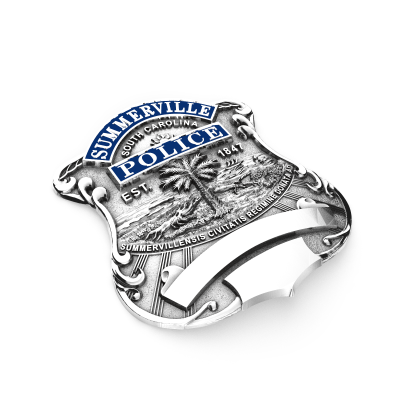What do common badge symbols mean?
Understanding the meaning of heraldic and historical symbols in badge design.

Your badge is an iconic symbol of your profession, and most badges have design elements with heraldic or historical symbolism. Some commonly used symbols originate from Ancient Greece and Rome, while others get their meaning from Europe’s heraldic arts. Understanding how the meaning of these symbols has been used throughout history, could influence your decision when designing a badge.
In this article, we will share the most commonly used symbols on a badge and briefly define their meaning. We'll explore why understanding the historical meaning of symbolic elements is important, not only for creating a visually appealing badge but also for choosing a style with a deeper sense of connection. We will also talk about using symbols that have traditional or departmental meanings on your badge. By understanding the symbols on the badge you are considering for your department, your selection will represent your department and instill a sense of pride and ownership among its wearers.
What does an Eagle symbolize on a police hat badge or shield?
An Eagle on a police hat badge represents the Federal Government as the highest governing authority, defender of the Constitution, and law enforcer. Eagle top shields reference the Federal Government as well. The Eagle symbolizes strength and protection, starting with the Federal Government and continuing to state and local governments.

What does a Maltese Cross symbolize on a badge?
In the context of a badge or insignia, especially in the emergency services and firefighting, the Maltese cross often represents courage, sacrifice, and a commitment to helping others. It is commonly used as a symbol for fire departments, paramedics, and other emergency services worldwide.

What does a laurel leaf symbolize on a badge?
On a law enforcement badge, the laurel leaf represents honor, competence, and respect. Laurels can also be interpreted to include strength and education. As a small tree or shrub, laurel leaves are evergreen so their leaves remain green and in bloom all year long. The leaves lightly overlap on their branches and are thought to be a symbol of purity, virtue, and integrity. Laurels are rendered as branches, u-shaped wreaths, or full circle wreaths on a badge and were first used in Ancient Greece and Rome to crown victors.

What does a wreath symbolize on a badge?
A wreath on a public safety badge symbolizes life. A laurel wreath represents strength and the responsibility to protect life. Oak leaves and olive branches are also used for wreaths. Oak symbolizes strength, steadfastness, and loyalty. Olive branches typically symbolize service in peacetime and war. A wreath is either a U-shape or a full circle, depending on its meaning. Napoleon Bonaparte chose a laurel wreath crown made of gold, emulating the Roman General and statesman Julius Caesar for his coronation.

What does a sunray symbolize on a badge?
It depends on how you look at them! Sunrays in general, are symbolic of warmth, happiness, and energy. Sunrays sometimes reflect a story of the setting sun. In a full custom badge, a specific number of sunrays may serve as a symbol of core values, a memorial tribute, or a representation of the department’s geographic location. In badge design, there are three main styles of sunrays: the bevel sunray, the flat sunray, and what is known as a “sunburst.” The LAPD originated the beveled sunray, but they are now commonly found in many oval badges due to their distinct style and tradition.

What does a fire scramble symbolize on a badge?
Fire department badges often show a fire scramble as the center seal. A fire scramble is a grouping of modern and traditional fire symbols. Design elements can feature a ladder, an axe, helmets, fire hydrants, a bugle, or a pike pole. When grouped, these fire tools of the trade symbolize preparedness and readiness. Fire department insignia symbolizes trust that the firefighter has arrived on the scene to protect life and property. Tools for organized firefighting have their roots in Ancient Greece and Rome, carrying through Medieval Europe and into the American Colonies. Tools of the trade, from bucket brigades to hoses and pumps, show technological advancement.

What do crests and seals symbolize on a badge?
A crest is a heraldic symbol or pattern on the coat of arms, which is on a shield or escutcheon in proper heraldic terms. A seal was historically recognized as a signature in wax, or the stamp that created the symbol. Typically, the seal would be the entire coat or arms or a part of it. Crests and seals are most often used in federal and municipal government agencies. Today, seals are commonly found on the center of a badge. They can be state seals or even a custom-designed option, but they are depicted in metal or enamel or a combination of both.

Why is knowing historical symbolism important in badge design?
Knowing some information about the historical symbolism behind common badge elements connects ancient symbols to contemporary badge design through their symbolic meanings. Take one example, the Maltese Cross, which is often the foundational element of a firefighter badge. There is a historical relationship between the Maltese Cross and firefighting that dates back to the Crusades, which provides a deeper meaning to this symbol. The origin of the Maltese cross can be traced back to the Crusades, where brave knights, The Knights of St John of Malta, wore this heraldic cross on their tunics while facing the onslaught of the Saracens. Fire was a popular weapon during the Crusades. The Knights of St John were heroic in battling these fires and were recognized as the world's first firefighters for their courage in battling the fires. The Maltese cross continues to be a powerful symbol of bravery, sacrifice, and service to others, particularly within the firefighting community.
What about the meaning of my department’s traditional symbols?
Symbols on a badge can also have departmental meaning, or historical tradition in your community. For example, sunrays do not always represent the setting sun, a specific number of sunrays could serve as a memorial tribute to fallen officers or represent the number of a department’s core values. The use of symbols is largely a personal choice to provide a desired look for your badge, but department tradition or choosing an element for deeper meaning is always an option.
Whether you are using our online badge builder, VisualBadge, or working with the design team in BadgeStudio, you will discover many of these common badge symbols in your design process. Many of these symbols date back to Ancient Greece or Rome and were picked up by Europe’s knights, kings, and emperors throughout history, and continue to be used as part of badge design in the twenty-first century! Their symbolic meanings might have remained the same or become important to your department for traditional reasons, but these common symbols remain a very important part of badge design. Your badge connects you and your fellow officers to the past, present, and future of public safety. At Smith & Warren, our badge experts know a lot about the history and deeper meaning of heraldic symbols, so just contact us if you ever want to know why a symbol is on a badge.



